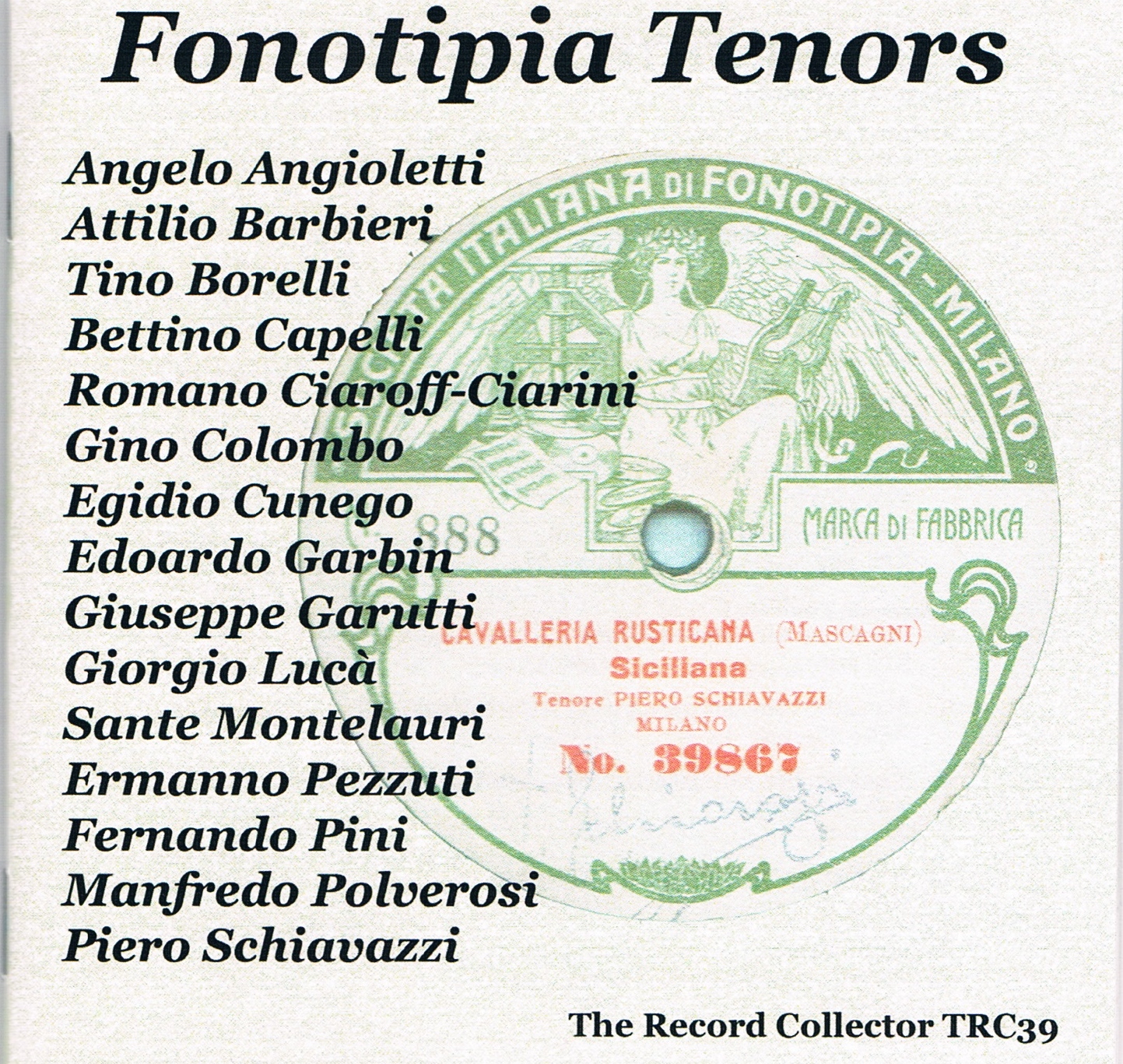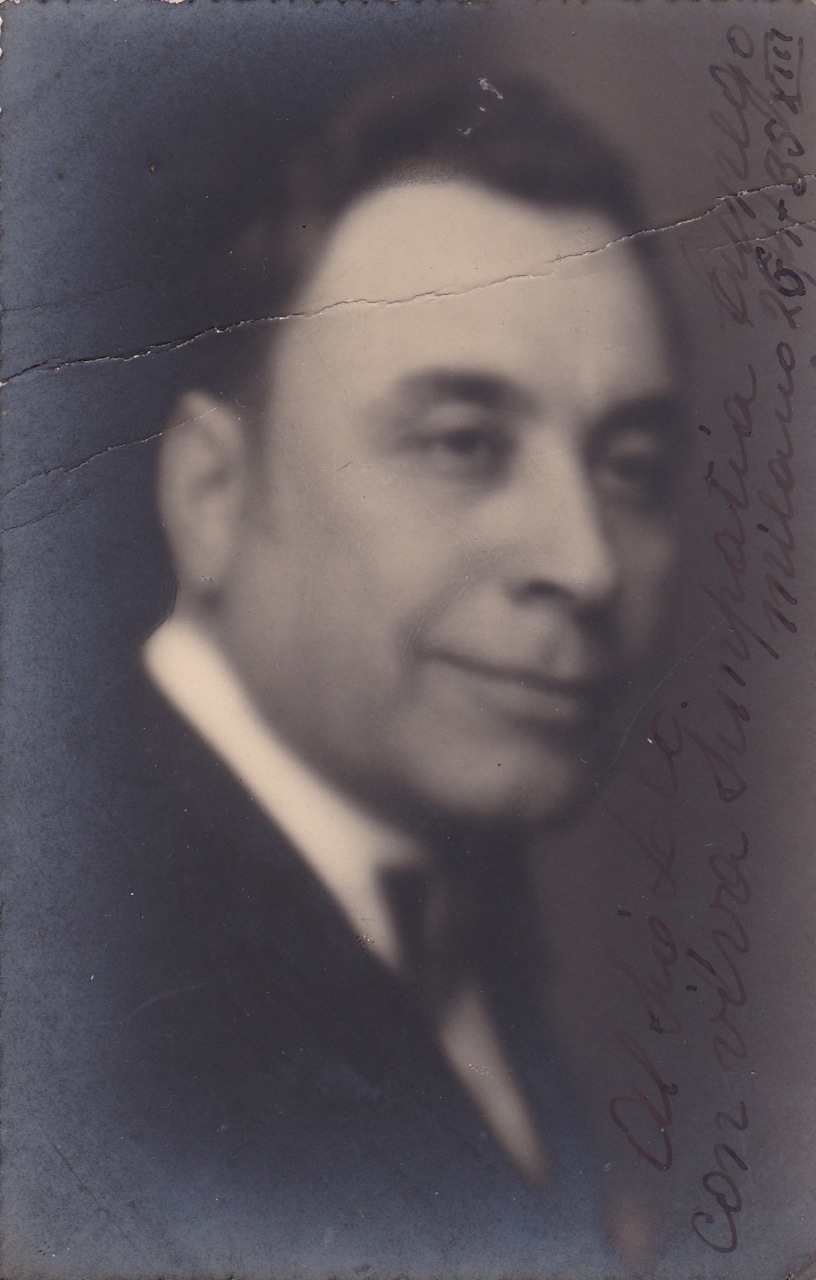
 (Egidio Cunego, courtesy Charles Mintzer collection)
(Egidio Cunego, courtesy Charles Mintzer collection)FONOTIPIA TENORS
2 CD’s The Record Collector TRC39

 (Egidio Cunego, courtesy Charles Mintzer collection)
(Egidio Cunego, courtesy Charles Mintzer collection)
Finally Messrs. Lustig and Bilgora have got it. At last they realized that the market for historical vocal issues is rather limited and so are sales. Therefore a publisher should concentrate on recordings that are not available somewhere else or that have already been issued twenty or even thirty years ago on LP. Earlier TRC’s like the Cetra tenors, sopranos and baritones always were interesting but often almost a third or even half of the issue had been available or could be found on Preiser, Bongiovanni etc. and with the internet it was no longer impossible to find those interesting well produced LP’s on Rubini, Preiser, Court Opera, Rococo etc. Therefore congratulations and many thanks for this double CD. I meticulously checked my LP album Fonotipia Tenors (five LP’s) Volume One on Rubini (I don’t think there ever was a volume two) and there is no single doubling with this issue though tenors like Polverosi, Garbin and Schiavazzi figure in both albums, be it with different recordings. As far as I know only the Schiavazzi arias are to be found elsewhere on Bongiovanni’s Il Mito dell’ Opera recital by the tenor. No one is credited with pitching decisions (on Rubini an immaculate job was done by that “well-known London dealer” Richard Bebb) but nowhere did I even get the slightest feeling a voice sounded too high or too low. Moreover the sound quality of some of these very difficult to find recordings is always state of the art; an example of fine transfers. Compared to the Rubini box there is one feature lacking though the Record Collector cannot be faulted. Sleeve notes (in this issue in great detail researched by Alan Bilgora) don’t have the LP booklet format and sadly big photographs are no longer possible.
That formidable Rubini album mixed recordings of still known tenors like Borgatti, De Lucia, Garbin, Schiavazzi, Lauri-Volpi, Krismer, Bonci, Gilion, Palet with lesser luminaries like Longobardi, Acerbi, Schenoni or Capelli. These CD’s concentrate mostly on tenor names which will hardly ring a bell with even hardened non-shellac collectors as your reviewer. The pleasure therefore of discovering some new voices or names who one vaguely remembers from a duet on Rubini, Club 99 or Oasi is great. The first CD is acoustics only. The issue starts with two recordings by Bettino Capelli; a worthy representative of the well-known provincial Italian tenor who for decades could make a decent living singing either in the 260 theatres of the peninsula or elsewhere in the wider world where an Italian tenor invariably was lauded as “from La Scala”; even though he sometimes had only seen the exterior of the building. Capelli sings somewhat harsh, sounds even noisy with his open aaa grating a bit but there is no denying the voice has a surplus of squillo that probably could cut through whatever orchestra or ensemble tried to drown him. In short, he sounds like a predecessor to Mario Filippeschi or Renato Francesconi. With Edoardo Garbin we are on better known terrain. His name will be remembered as the first Fenton and I have always wondered why Verdi did not demand a more mellifluous voice. Garbin sounds woolly and dry and not very Italianate, reminding me a bit of Edward Johnson’s. His uses a glottis coup to reach his high notes and his breathing is rather laboured. He takes a pause between “con la mia voce” and “ho cantato la patria” in “Si fui soldato” and aspirates when singing “h’uccidi” instead of “uccidi”. His open e is not likeable too and I’ve got the distinct impression he is singing a repertory too heavy. With four aria’s by Manfredo Polverosi however we are in excellent tenor land. This is the rich timbre to be found beneath the Alps. Maybe some people won’t like his rather obvious vibrato but I’m a fan. Together with strong high notes he proves to have a fine diminuendo too which he uses to great avail in Manon, Werther and Carmen though the top note of “Il fior” is taken full voice as no one at the time in Italy would have accepted otherwise. The to me completely unknown Ermanno Pezzuti sings an aria from Fedora and Cavalleria. Alan Bilgora stresses the fact the tenor makes much of that fine Giordano cantilena, not just bawling it and he regrets that the voice is somewhat bland. For once I like to disagree with Mr. Bilgora as I find the sound far richer than he does. With Bilgora’s opinion on Romano Ciaroff-Ciarini’s recordings (“His is a truly fascinating talent”) one can only agree. The Russian born tenor has the real Italian sound with a brilliant top reminding me somewhat of young Gigli’s recordings; small sobs included though the Russian’s voice is a bit darker. The Greek tenor Giorgio Lucà clearly is a lesser talent with a thinner sound and without much charm in “Una furtive lagrima”. Piero Schiavazzi on the other hand is a major voice. His high lying and well focused voice with strong top notes is excellent in Mascagni and Puccini’s Manon Lescaut. His timbre is clear, sometimes a bit white but always agreeable. Typical for the tenor, indeed for all singers on this first CD, is their stylish singing. They don’t sob their heart out and try not to break the musical line for effect; no doubt the result from the fact most of them were born in the seventies or eighties of the 19th century and thus they still belong to the old school though almost of their recordings on this CD are devoted to “modern” music by living composers as Mascagni, Puccini, Boito, Giordano, Leoncavallo. The first CD ends with an impressive “Si pel ciel” by Angelo Angioletti; a true heroic voice though a little unwieldy.
The second CD is devoted to electric recordings and indeed the style has slightly coarsened as well there is no single singer who belongs to the excessive school of guffawing, sobbing etc. we remember from guys like Chiaia, Zerola, Lois, Masini, Melandri and late Gigli. The CD starts with the bright voiced tenor Egidio Cunego in a duet from Fedora. I’m more impressed with the strong voiced soprano Etty Maroli; a name new to me. Quite a discovery are the recordings by Gino Colombo whose duets with Vera Amerighi-Rutili and Lina Lanza prove that Fonotipia considered him worthy enough to record with better known singers. It seems strange that Mr. Bilgora was not able to find performances with the tenor in the many chronologies he consulted. Was Colombo a recording artist only ? a radio singer ? (Bilgora found two performances as a comprimario at RAI). Thus, a kind of mystery tenor. Colombo is a successor to Zenatello and a predecessor of Prevedi, Bergonzi and Garaventa as he too started as a baritone ( Bilgora discovered two in house roles). There are less baritone hints in the voice than shown in the early recordings of Prevedi or Bergonzi. The voice is bright, with a slight vibrato and rich in colour. I’m reminded of Antonio Salvarezza. Bilgora tells us Colombo was the second tenor to record “Nessun dorma” (after Merli in 1926) and like the better known singer he doesn’t go for the B flat which is not in the score. One year later top note hunters had already discovered the possibilities of milking applause with that note and the aria was never again the same (Puccini probably would have approved if he had lived). Another new name to me is tenor Sante Montelauri singing “Già nella notte densa” with Anna Marcangeli. Once more I have to admit the soprano’s name was unknown too to me and she is a glorious and strong Desdemona. I doubt she would have willingly let him strangle her. The tenor can only be described as a poor man’s Aureliano Pertile: the same basic sound, but a bit more vulgar, more ugly. The producer had the good idea of including two aria’s by a pop singer. Fernando Pini belonged to the Italian school of popular singers who employed belcanto technique and whose timbres were often as beautiful as the best operatic performers. Either they thought their voice too light to overcome an orchestra or they wanted their career to last as long as possible; therefore they preferred singing on radio or performing with a microphone and they sometimes recorded an operatic aria. The best known of the bunch was the immensely popular Carlo Buti (23 pages in the pre-war record catalogues; Gigli had 6). On record Pini seems to have a more operatic voice than Buti in two smooth arias from Don Pasquale. Alan Bilgora calls Pini a tenorino which is probably correct though on record the impression is one of a real voice with substance. Anyway, I’d like to hear him in his popular repertoire. With seven selections Tino Borelli gets the lion share on this CD and they are all worth listening too. He too has a brilliant top and bright metal in the voice but the singing is always stylish. I rate him even higher than Polverosi and as “voce parallela” he reminds the listener of Francesco Merli. What an abundance of talent Italy still had in those years as Bilgora’s notes reveal Borelli had to limit his career to performances in the provinces or with touring companies. Only in the details it is clear why he had no major career. His “A te, o cara” is transposed down and he has no messa di voce like Bonci and Lauri-Volpi in their recordings. The metal in the voice too lacks the necessary morbidezza for poor Fritz’s lament but all in all we miss this kind of dramatic singing so much nowadays. The same can be said of Giuseppe Garutti’s single contribution in Loreley. The last one to figure on this CD is Attilio Barbieri; again a new name. The voice has a tremendous cutting edge to it and his somewhat sharp sound is incisive and brilliant in the two aria’s from Isabeau. Indeed, I know of no better version. Gigli and Del Monaco were over the top when they recorded the aria’s and Piero Miranda Ferraro is pedestrian in the complete recording. Barbieri even surpasses the better known though nasal “O colombelle” by Hipolito Lazaro.
There can be only one conclusion. Vocal and especially tenor buffs need to pick up this issue and I sincerely hope Larry Lustig and Alan Bilgora will further issue CD’s with this unhackneyed choice of performers. The soprano’s one hears on these CD’s wet one’s appetite. Of course I remember the late and lamented Michael Thomas in his legendary shop on Lymington Street off Finchley Road where one risked breaking one’s legs or arms while trying to browse in his jumble of boxes filled to the brim with LP’s by historical singers: “Anyway they only buy the tenors.” I’m sure the producers are able to surprise us with another astounding numbers of records by forgotten soprano’s, baritones, basses (with a fair smattering of duo’s, trio’s etc, with tenors for “the tenors only” public.).
Jan Neckers